tire size TOYOTA iA 2016 Owners Manual (in English)
[x] Cancel search | Manufacturer: TOYOTA, Model Year: 2016, Model line: iA, Model: TOYOTA iA 2016Pages: 588, PDF Size: 5.15 MB
Page 132 of 588
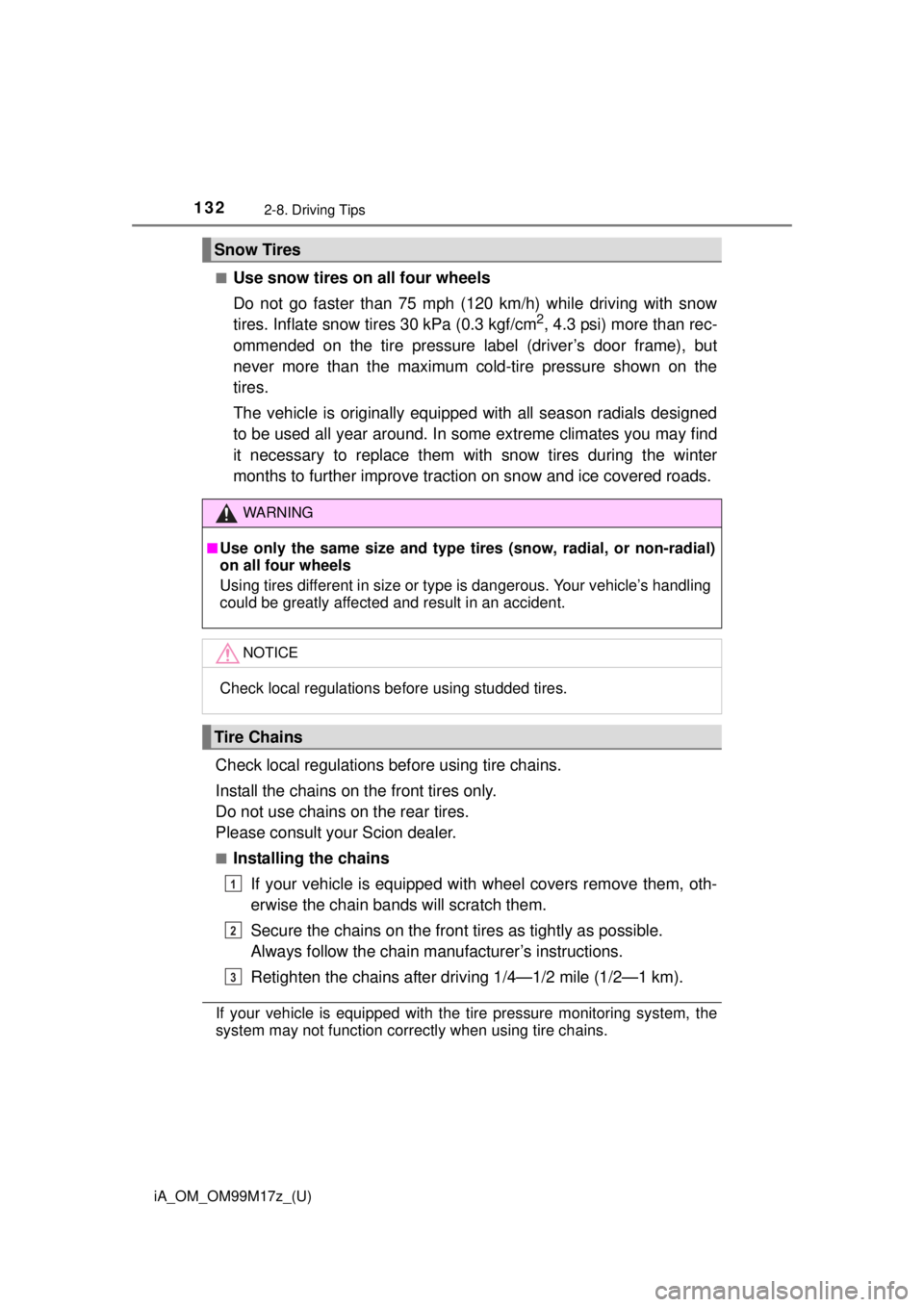
132
iA_OM_OM99M17z_(U)
2-8. Driving Tips
■Use snow tires on all four wheels
Do not go faster than 75 mph (120 km/h) while driving with snow
tires. Inflate snow tires 30 kPa (0.3 kgf/cm
2, 4.3 psi) more than rec-
ommended on the tire pressure label (driver’s door frame), but
never more than the maximum cold-tire pressure shown on the
tires.
The vehicle is originally equipped with all season radials designed
to be used all year around. In some extreme climates you may find
it necessary to replace them with snow tires during the winter
months to further improve traction on snow and ice covered roads.
Check local regulations bef ore using tire chains.
Install the chains on the front tires only.
Do not use chains on the rear tires.
Please consult your Scion dealer.
■Installing the chains If your vehicle is equipped with wheel covers remove them, oth-
erwise the chain bands will scratch them.
Secure the chains on the front tires as tightly as possible.
Always follow the chain manufacturer’s instructions.
Retighten the chains after driving 1/4—1/2 mile (1/2—1 km).
If your vehicle is equipped with the tire pressure monitoring system, the
system may not function correctly when using tire chains.
Snow Tires
WARNING
■Use only the same size and type tires (snow, radial, or non-radial)
on all four wheels
Using tires different in size or type is dangerous. Your vehicle’s handling
could be greatly affected and result in an accident.
NOTICE
Check local regulations before using studded tires.
Tire Chains
1
2
3
Page 196 of 588
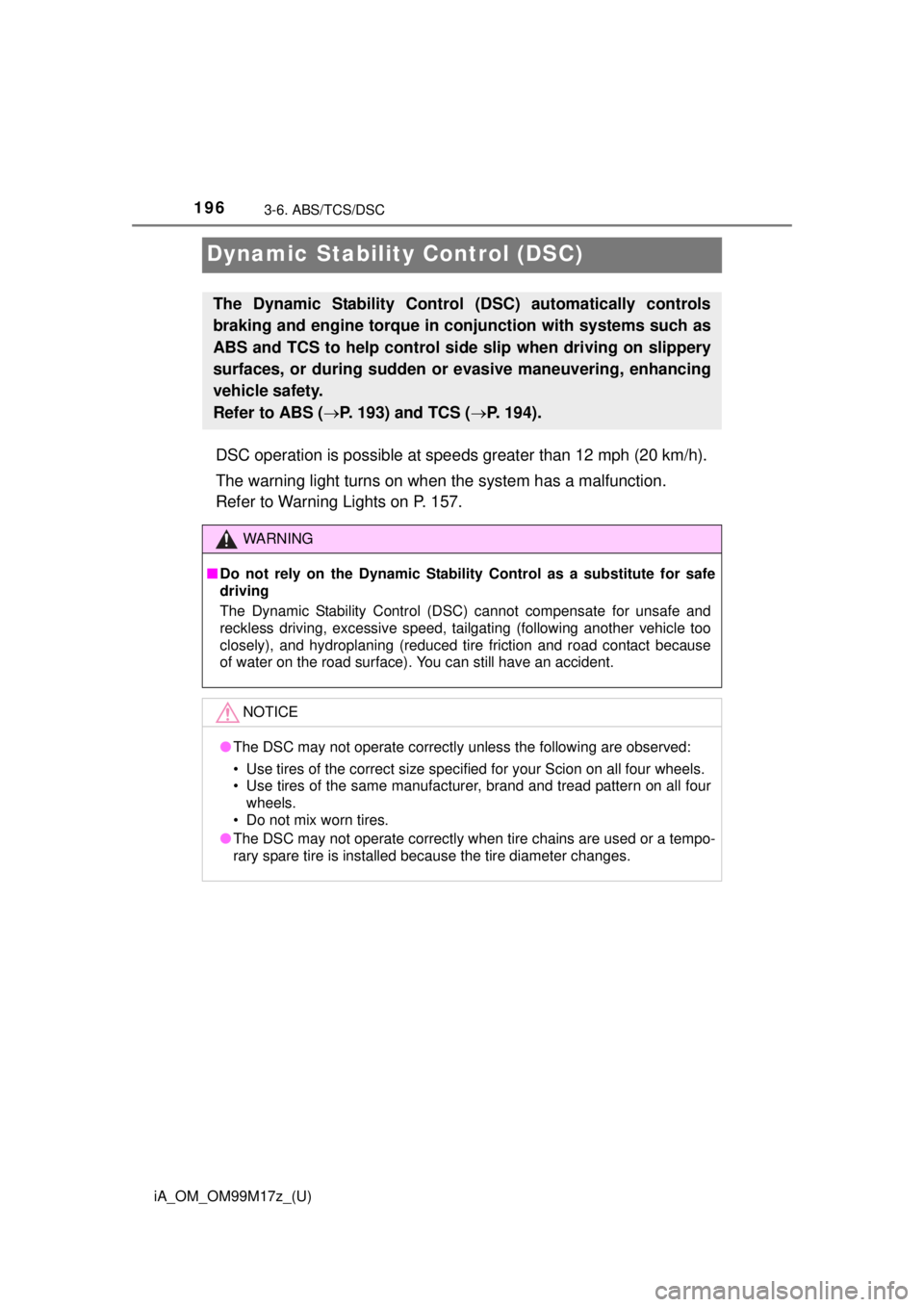
196
iA_OM_OM99M17z_(U)
3-6. ABS/TCS/DSC
Dynamic Stability Control (DSC)
DSC operation is possible at speeds greater than 12 mph (20 km/h).
The warning light turns on when the system has a malfunction.
Refer to Warning Lights on P. 157.
The Dynamic Stability Control (DSC) automatically controls
braking and engine torque in conjunction with systems such as
ABS and TCS to help control side slip when driving on slippery
surfaces, or during sudden or e vasive maneuvering, enhancing
vehicle safety.
Refer to ABS ( P. 193) and TCS ( P. 194).
WARNING
■Do not rely on the Dynamic Stabil ity Control as a substitute for safe
driving
The Dynamic Stability Control (DSC) cannot compensate for unsafe and
reckless driving, excessive speed, tailgating (following another vehicle too
closely), and hydroplaning (reduced tire friction and road contact because
of water on the road surface). You can still have an accident.
NOTICE
● The DSC may not operate correctly unless the following are observed:
• Use tires of the correct size specified for your Scion on all four wheels.
• Use tires of the same manufacturer, brand and tread pattern on all four
wheels.
• Do not mix worn tires.
● The DSC may not operate correctly when tire chains are used or a tempo-
rary spare tire is installed because the tire diameter changes.
Page 209 of 588
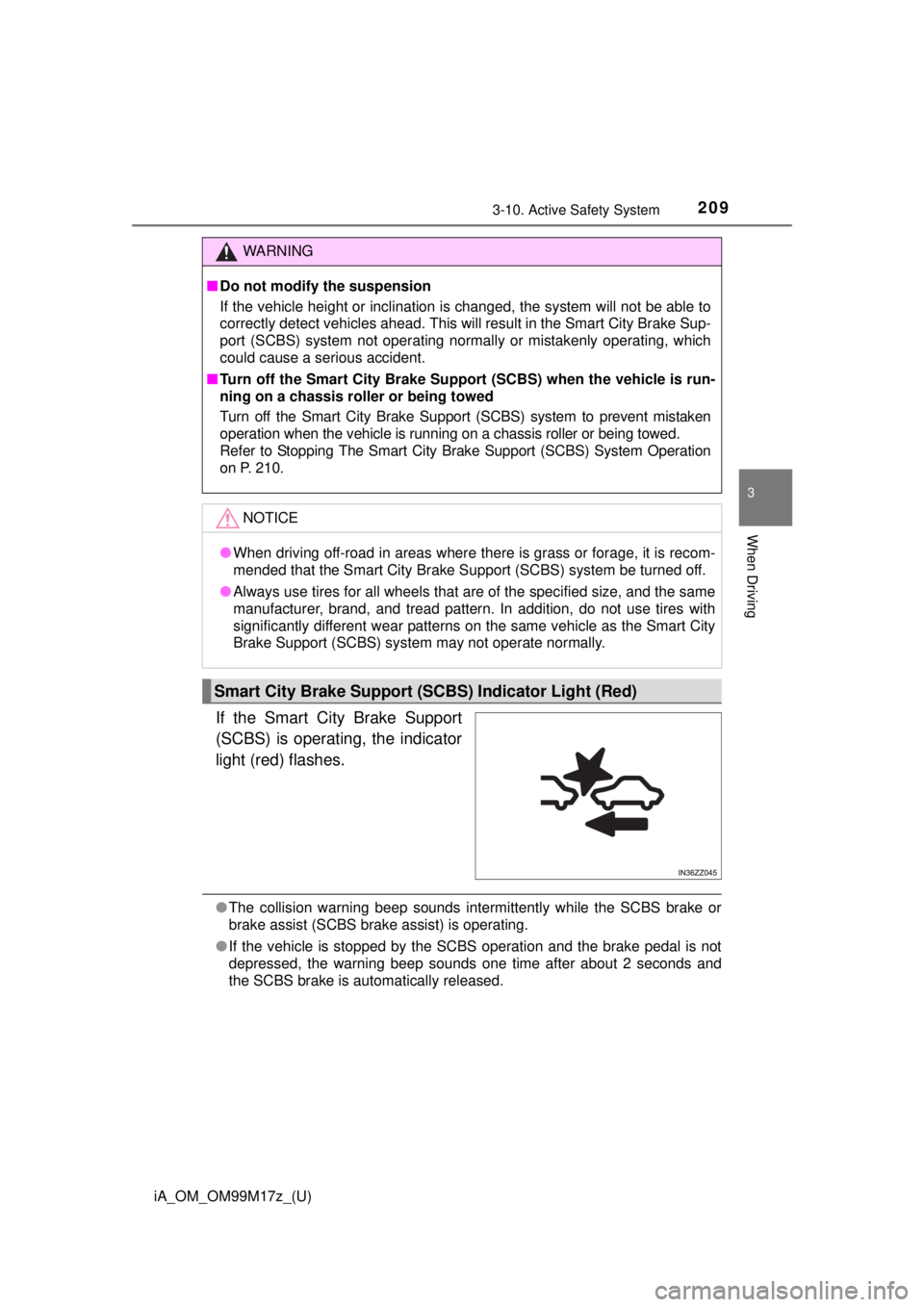
iA_OM_OM99M17z_(U)
2093-10. Active Safety System
3
When Driving
If the Smart City Brake Support
(SCBS) is operating, the indicator
light (red) flashes.
●The collision warning beep sounds intermittently while the SCBS brake or
brake assist (SCBS brake assist) is operating.
● If the vehicle is stopped by the SCBS operation and the brake pedal is not
depressed, the warning beep sounds one time after about 2 seconds and
the SCBS brake is automatically released.
WARNING
■Do not modify the suspension
If the vehicle height or inclination is changed, the system will not be able to
correctly detect vehicles ahead. This will result in the Smart City Brake Sup-
port (SCBS) system not operating normally or mistakenly operating, which
could cause a serious accident.
■ Turn off the Smart City Brake Support (SCBS) when the vehicle is run-
ning on a chassis roller or being towed
Turn off the Smart City Brake Support (SCBS) system to prevent mistaken
operation when the vehicle is running on a chassis roller or being towed.
Refer to Stopping The Smart City Brake Support (SCBS) System Operation
on P. 210.
NOTICE
● When driving off-road in areas where there is grass or forage, it is recom-
mended that the Smart City Brake Support (SCBS) system be turned off.
● Always use tires for all wheels that are of the specified size, and the same
manufacturer, brand, and tread pattern. In addition, do not use tires with
significantly different wear patterns on the same vehicle as the Smart City
Brake Support (SCBS) system may not operate normally.
Smart City Brake Support (SCBS) Indicator Light (Red)
Page 219 of 588

iA_OM_OM99M17z_(U)
2193-12. Tire Pressure Monitoring System
3
When Driving
Because this system detects slight changes in tire conditions, the timing
of the warning may be faster or slower in the following cases:
●The size, manufacturer, or the type of tires is different from the specifica-
tion.
●The size, manufacturer, or the type of a tire is different from the others,
or the level of tire wear is excessively different between them.
●A run-flat tire, studless tire, snow tire, or tire chains are used.
●An emergency tire is used (The tire pressure monitoring system warning
light may flash and then continue illuminating).
●A tire is repaired using the emergency flat tire repair kit.
●The tire pressure is excessively hi gher than the specified pressure, or
the tire pressure is suddenly lowered for some reason such as a tire
burst during driving.
●The vehicle speed is lower than about 9.3 mph (15 km/h) (including
when the vehicle is stopped), or t he drive period is shorter than 5 min-
utes.
●The vehicle is driven on an extremely rough road or a slippery, icy road.
●Hard steering and rapid acceleration/deceleration are repeated such as
during aggressive driving on a winding road.
●Load on the vehicle is applied to a tire such as by loading heavy luggage
to one side of the vehicle.
●System initialization has not been im plemented with the specified tire
pressure.
Page 220 of 588

220
iA_OM_OM99M17z_(U)
3-12. Tire Pressure Monitoring System
NOTICE
●Each tire, including the spare (if provided), should be checked monthly
when cold and inflated to the inflation pressure recommended by the
vehicle manufacturer on the vehicle placard or tire inflation pressure
label. (If your vehicle has tires of a different size than the size indicated
on the vehicle placard or tire inflation pressure label, you should deter-
mine the proper tire inflation pressure for those tires.)
As an added safety feature, your vehicle has been equipped with a tire
pressure monitoring system (TPMS) that illuminates a low tire pres-
sure telltale when one or more of your tires is significantly under-
inflated. Accordingly, when the low tire pressure telltale illuminates,
you should stop and check your tires as soon as possible, and inflate
them to the proper pressure. Driving on a significantly under-inflated
tire causes the tire to overheat and can lead to tire failure. Under-infla-
tion also reduces fuel efficiency and tire tread life, and may affect the
vehicle’s handling and stopping ability.
Please note that the TPMS is not a substitute for proper tire mainte-
nance, and it is the driv er’s responsibility to main tain correct tire pres-
sure, even if under-inflation has not reached the level to trigger
illumination of the TPMS lo w tire pressure telltale.
Your vehicle has also been equipped with a TPMS malfunction indica-
tor to indicate when the system is not operating properly.
The TPMS malfunction indicator is combined with the low tire pressure
telltale. When the system detects a malfunction, the telltale will flash
for approximately one minute and then remain continuously illumi-
nated. This sequence will continue upon subse quent vehicle start-ups
as long as the malfunction exists . When the malfunction indicator is
illuminated, the system ma y not be able to detect or signal low tire
pressure as intended. TPMS malfunctions may occur for a variety of
reasons, including the installation of replacement or alternate tires or
wheels on the vehicle that prevent the TPMS from functioning properly.
Always check the TPMS malfunction telltale after replacing one or
more tires or wheels on your vehi cle to ensure that the replacement or
alternate tires and wheels allow the TPMS to continue to function prop-
erly.
●To avoid false readings, the system samples for a little while before
indicating a problem. As a result it will not instantaneously register a
rapid tire deflation or blow out.
Page 446 of 588
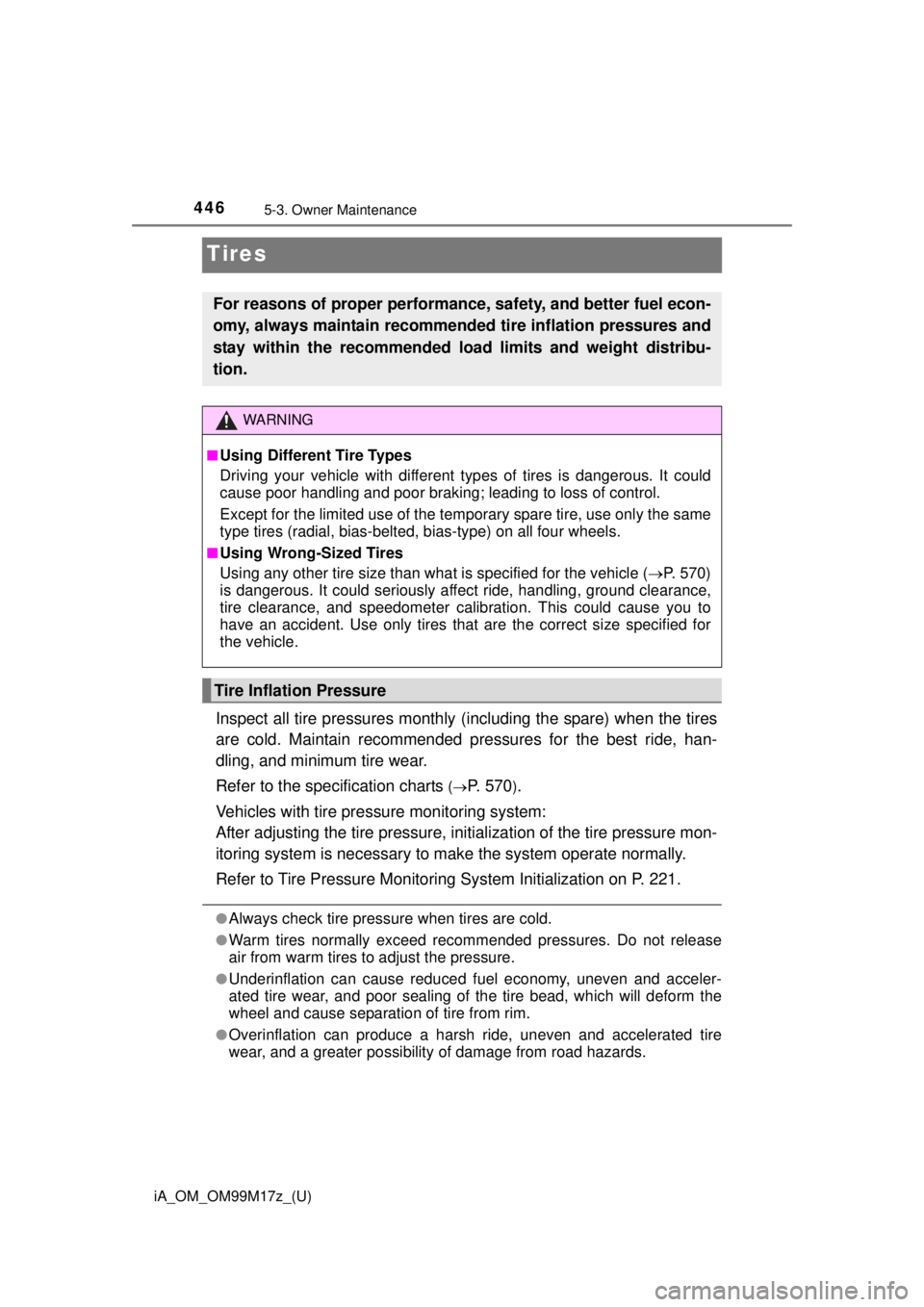
446
iA_OM_OM99M17z_(U)
5-3. Owner Maintenance
Tires
Inspect all tire pressures monthly (including the spare) when the tires
are cold. Maintain recommended pressures for the best ride, han-
dling, and minimum tire wear.
Refer to the specification charts
( P. 570).
Vehicles with tire pres sure monitoring system:
After adjusting the tire pressure, initialization of the tire pressure mon-
itoring system is necessary to make the system operate normally.
Refer to Tire Pressure Monitoring System Initialization on P. 221.
●Always check tire pressure when tires are cold.
●Warm tires normally exceed recommended pressures. Do not release
air from warm tires to adjust the pressure.
●Underinflation can cause reduced fuel economy, uneven and acceler-
ated tire wear, and poor sealing of the tire bead, which will deform the
wheel and cause separation of tire from rim.
●Overinflation can produce a harsh ride, uneven and accelerated tire
wear, and a greater po ssibility of damage from road hazards.
For reasons of proper performance, safety, and better fuel econ-
omy, always maintain recommended tire inflation pressures and
stay within the recommended lo ad limits and weight distribu-
tion.
WARNING
■Using Different Tire Types
Driving your vehicle with different ty pes of tires is dangerous. It could
cause poor handling and poor braking; leading to loss of control.
Except for the limited use of the temporary spare tire, use only the same
type tires (radial, bias-belted, bias-type) on all four wheels.
■Using Wrong-Sized Tires
Using any other tire size than what is specified for the vehicle (P. 570)
is dangerous. It could seriously affect ride, handling, ground clearance,
tire clearance, and speedometer calibration. This could cause you to
have an accident. Use only tires that are the correct size specified for
the vehicle.
Tire Inflation Pressure
Page 450 of 588
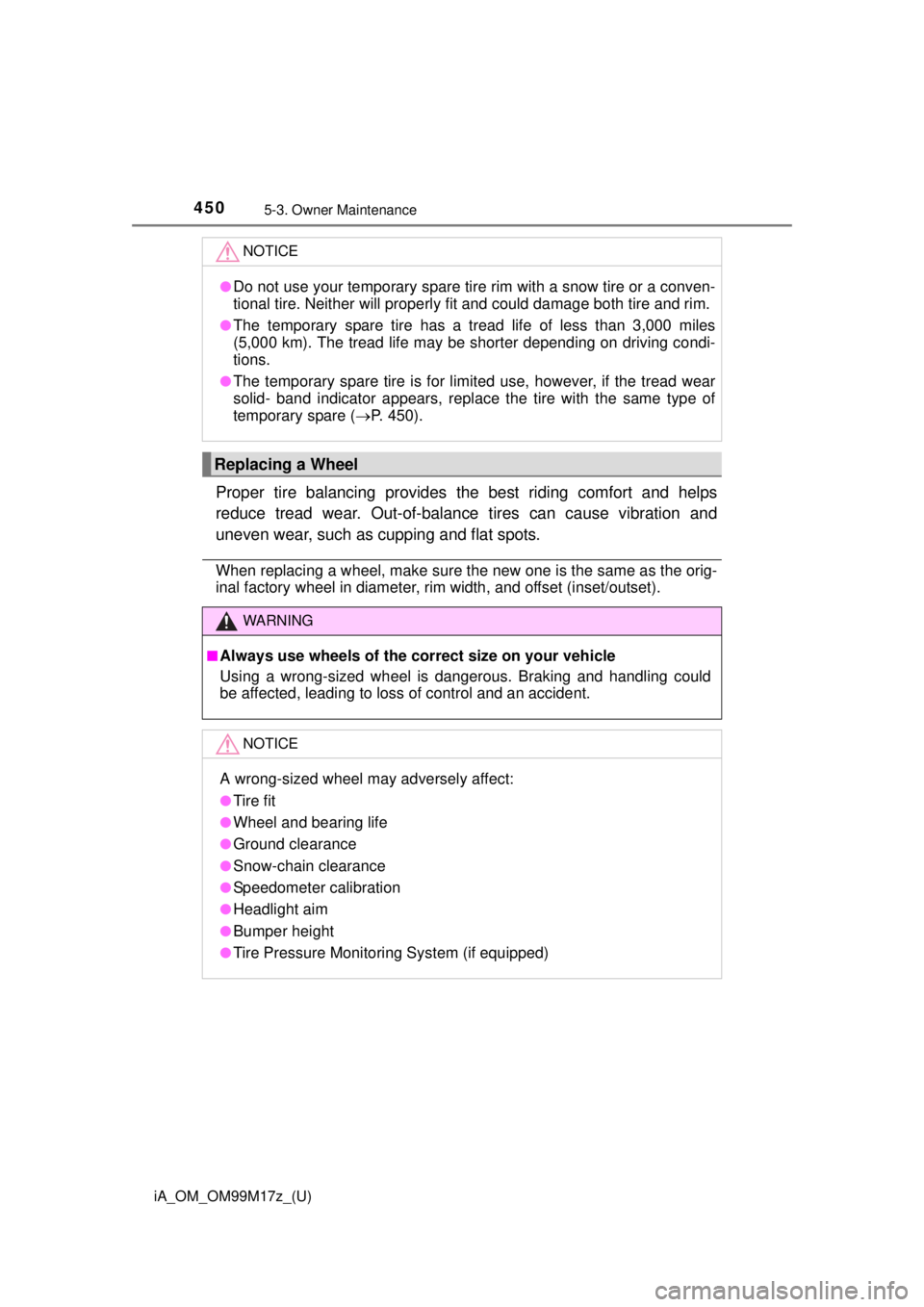
4505-3. Owner Maintenance
iA_OM_OM99M17z_(U)
Proper tire balancing provides the best riding comfort and helps
reduce tread wear. Out-of-balance tires can cause vibration and
uneven wear, such as cupping and flat spots.
When replacing a wheel, make sure the new one is the same as the orig-
inal factory wheel in diameter, rim width, and offset (inset/outset).
NOTICE
●Do not use your temporary spare tire rim with a snow tire or a conven-
tional tire. Neither will properly fit and could damage both tire and rim.
●The temporary spare tire has a tread life of less than 3,000 miles
(5,000 km). The tread life may be shorter depending on driving condi-
tions.
●The temporary spare tire is for limited use, however, if the tread wear
solid- band indicator appears, replace the tire with the same type of
temporary spare ( P. 450).
Replacing a Wheel
WARNING
■Always use wheels of the correct size on your vehicle
Using a wrong-sized wheel is dangerous. Braking and handling could
be affected, leading to loss of control and an accident.
NOTICE
A wrong-sized wheel may adversely affect:
●Tire fit
●Wheel and bearing life
●Ground clearance
●Snow-chain clearance
●Speedometer calibration
●Headlight aim
●Bumper height
●Tire Pressure Monitoring System (if equipped)
Page 487 of 588
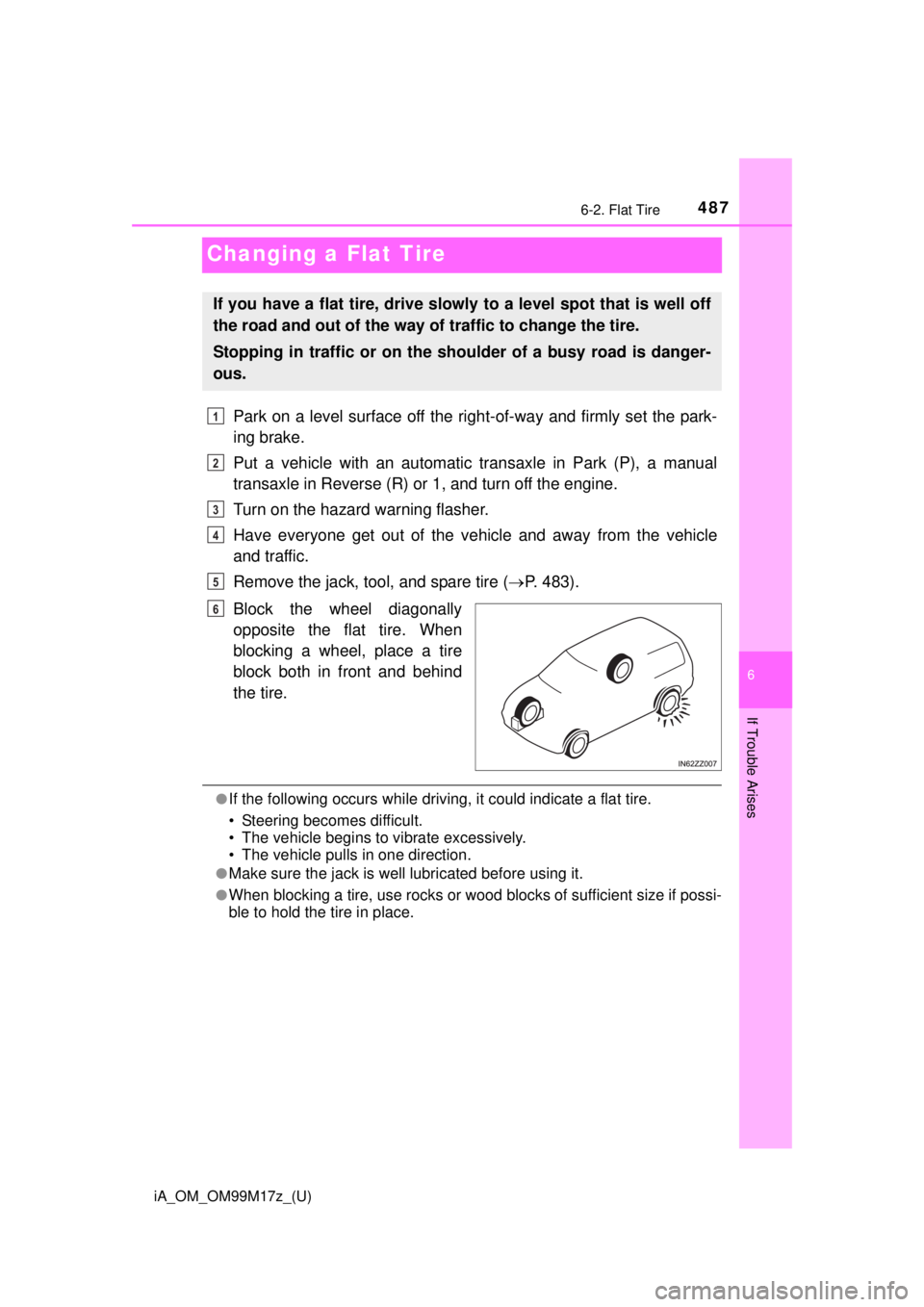
487
iA_OM_OM99M17z_(U)
6-2. Flat Tire
6
If Trouble Arises
Changing a Flat Tire
Park on a level surface off the right-of-way and firmly set the park-
ing brake.
Put a vehicle with an automatic transaxle in Park (P), a manual
transaxle in Reverse (R) or 1, and turn off the engine.
Turn on the hazard warning flasher.
Have everyone get out of the v ehicle and away from the vehicle
and traffic.
Remove the jack, tool, and spare tire ( P. 483).
Block the wheel diagonally
opposite the flat tire. When
blocking a wheel, place a tire
block both in front and behind
the tire.
●If the following occurs wh ile driving, it could indicate a flat tire.
• Steering becomes difficult.
• The vehicle begins to vibrate excessively.
• The vehicle pulls in one direction.
●Make sure the jack is well lubricated before using it.
●When blocking a tire, use rocks or wood blocks of sufficient size if possi-
ble to hold the tire in place.
If you have a flat tire, drive slowly to a level spot that is well off
the road and out of the way of traffic to change the tire.
Stopping in traffic or on the shoulder of a busy road is danger-
ous.
1
2
3
4
5
6
Page 542 of 588

542
iA_OM_OM99M17z_(U)
7-7. Tire Information (U.S.A.)
P215/65R15 95H is an example of a tire size and load index rating.
Here is an explanation of the various components of that tire size and
load index rating. Note that the tire size and load index rating may be
different from the example.
●P
Indicates a tire that may be installed on cars, SUVs, minivans and
light trucks as designated by the Tire and Rim Association (T&RA).
● 215
“215” is the nominal width of the tire in millimeters. This three-digit
number gives the width in millimeters of the tire from sidewall edge
to sidewall edge. In general, the larger the number, the wider the
tire.
● 65
“65” is the aspect ratio. This two-digit number indicates the tire’s
ratio of height to width.
● R
“R” is the tire construc tion symbol. R indicates “Radial ply construc-
tion”.
● 15
“15” is the wheel rim diameter in inches.
● 95
“95” is the Load Index. This two-or three-digit number indicates how
much weight each tire can support.
● H
“H” is the speed rating. The s peed rating denotes the maximum
speed for which the use of the tire is rated.
Page 544 of 588

544
iA_OM_OM99M17z_(U)
7-7. Tire Information (U.S.A.)
■Maximum Load Rating
This number indicates the maximum load in kilograms and pounds
that can be carried by the tire.
■Maximum Permissible Inflation Pressure
This number is the greatest amount of air pressure that should ever
be put in the tire under normal driving conditions.
■Tread Wear, Traction and Temperature Grades
● Tread wear: The tread wear grade is a comparative rating based
on the wear rate of the tire wh en tested under controlled condi-
tions on a specified government te st course. For example, a tire
graded 150 would wear one and one-half (1 1/2) times as well on
the government course as a tire graded 100.
● Traction: The traction grades, from highest to lowest are AA, A,
B, and C. The grades represent the tire’s ability to stop on wet
pavement as measured under cont rolled conditions on specified
government test surfaces of as phalt and concrete. A tire marked
C may have poor traction performance.
● Temperature: The temperature gra des are A (the highest), B and
C, representing the tire’s resistance to the generation of heat and
its ability to dissipate heat when tested under controlled condi-
tions on a specified indoor laboratory test wheel.
■Snow Tires
In some heavy snow areas, local governments may require true
snow tires, those with very deeply cut tread. These tires should only
be used in pairs or placed on all four wheels. Make sure you pur-
chase snow tires that are the same size and construction type as
the other tires on your vehicle.
■SAFETY WARNING
The following safety warning appears on the tire’s sidewall. SERI-
OUS INJURY MAY RESULT FROM: • EXPLOSION OF TIRE/RIM ASSEMBLY DUE TO IMPROPER MOUNTING-MATCH TIRE DIAMETER TO RIM DIAMETER;
NEVER EXCEED 40 psi (275 kPa) TO SEAT BEADS-ONLY
SPECIALLY TRAINED PERSONS SHOULD MOUNT TIRES.
• TIRE FAILURE DUE TO UNDER-INFLATION/OVERLOADING/ DAMAGE- FOLLOW OWNER’S MANUAL AND PLACARD IN
VEHICLE-FREQUENTLY CHECK INFLATION PRESSURE AND
INSPECT FOR DAMAGE.